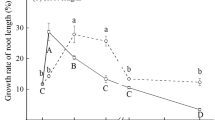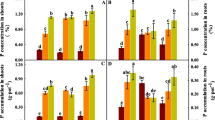Abstract
Aims
To clarify the effect of sulphate on the uptake and translocation of selenium (Se) by rape (Brassica napus L.) with Se applied as selenite or selenate.
Methods
Three hydroponic experiments were conducted at the seedling stage of B. napus. Selenium concentrations in plant and culture solution samples were analyzed by hydride generation atomic fluorescence spectrometry (HG-AFS-8220).
Results
The Se absorption capacity of B. napus supplied with selenate or selenite was the same at 0.1 mM sulphate. The translocation factor of Se was significantly reduced by up to 46.4 % with increasing selenite in solution, while sulphate had no effect on Se translocation in selenite treatment. The translocation factor of Se was substantially increased by up to 60.5 % with increasing selenate in solution, and the application of sulphate appeared to facilitate Se translocation in selenate treatment. The positive effect of sulphate was more significant with extended treatment time, but unrelated to selenate or sulphate concentration.
Conclusions
The Se absorption capacity of B. napus supplied with selenite or selenate depends on the concentration of sulphate. Sulphate is involved in the root-to-shoot translocation of Se in B. napus supplied with selenate, but not selenite. These results need confirming in pot and field trials.





Similar content being viewed by others
References
Berrow ML, Ure AM (1989) Geological materials and soils in occurrence and distribution of selenium. CRC Press, Boca Raton, pp 226–228
Broadley MR, Alcock J, Alford J, Cartwright P, Foot I, Fairweather-Tait SJ, Hart DJ, Hurst R, Knott P, McGrath SP, Meacham MC, Norman K, Mowat H, Scott P, Stroud JL, Tovey M, Tucker M, White PJ, Young SD, Zhao FJ (2010) Selenium biofortification of high-yielding winter wheat (Triticum aestivum L.) by liquid or granular Se fertilisation. Plant Soil 332:5–18
Cartes P, Gianfreda L, Mora M (2005) Uptake of selenium and its antioxidant activity in ryegrass when applied as selenate and selenite forms. Plant Soil 276:359–367
Cartes P, Shene C, Mora ML (2006) Selenium distribution in ryegrass and its antioxidant role as affected by sulfur fertilization. Plant Soil 285:187–195
Chen SY, Jiang RF, Li HF (2011) Uptake and traslocation of selenite or selenite by wheat and rice seedlings. Environ Sci 32:284–289
Chilimba ADC, Young SD, Black CR, Meacham MC, Lammel J, Broadley MR (2012) Assessing residual availability of selenium applied to maize crops in Malawi. Field Crop Res 134:11–18
Dhillon SK, Dhillon KS (2000) Selenium accumulation by sequentially grown wheat and rice as influenced by gypsum application in a seleniferous soil. Plant Soil 227:243–248
El Mehdawi AF, Pilon-Smits EAH (2012) Ecological aspects of plant selenium hyperaccumulation. Plant Biol 14:1–10
Ellis DR, Salt DE (2003) Plants, selenium and human health. Curr Opin Plant Biol 6:273–279
Epstein E (1966) Dual pattern of ion absorption by plant cells and by plants. Nature 212:1324–1327
Fellowes JW, Pattrick RAD, Boothman C, Al Lawati W, van Dongen B, Charnock J, Lloyd J, Pearce C (2013) Microbial selenium transformations in seleniferous soils. Eur J Soil Sci 64:629–638
Feng RW, Wei CY, Tu SX (2013) The roles of selenium in protecting plants against abiotic stresses. Environ Exp Bot 87:58–68
Fordyce F (2007) Selenium geochemistry and health. AMBIO: J Hum Environ 36:94–97
Fordyce FM, Selinus EO, Alloway B, Centeno JA, Finkelman RB, Fuge R, Lindh U, Smedley P (2005) Selenium deficiency and toxicity in the environment. In: Selinus O et al (eds) Essentials of medical geology. Elsevier Publishing, Philadelphia, pp 373–415
Harris J, Schneberg KA, Pilon-Smits EAH (2014) Sulfur-selenium-molybdenum interactions distinguish selenium hyperaccumulator Stanleya pinnata from non-hyperaccumulator Brassica juncea (Brassicaceae). Planta 239:479–491
Hawrylak-Nowak B (2013) Comparative effects of selenite and selenate on growth and selenium accumulation in lettuce plants under hydroponic conditions. Plant Growth Regul 70:149–157
Huang Y, Wang Q, Gao J, Lin ZQ, Bañuelos GS, Yuan LX, Yin XB (2013) Daily dietary selenium intake in a high selenium area of Enshi, China. Nutrients 5:700–710
Huang Q, Wang Q, Luo Z, Yu Y, Jiang R, Li H (2015) Effects of root iron plaque on selenite and selenate dynamics in rhizosphere and uptake by rice (Oryza sativa). Plant Soil 388:255–266
Keskinen R, Turakainen M, Hartikainen H (2010) Plant availability of soil selenate additions and selenium distribution within wheat and ryegrass. Plant Soil 333:301–313
Kikkert J, Hale B, Berkelaar E (2013) Selenium accumulation in durum wheat and spring canola as a function of amending soils with selenite, selenate and or sulphate. Plant Soil 372:629–641
Koralewska A, Buchner P, Stuiver CEE, Posthumus FS, Kopriva S, Hawkesfordb MG, De Kok LJ (2009) Expression and activity of sulfate transporters and APS reductase in curly kale in response to sulfate deprivation and re-supply. J Plant Physiol 166:168–179
Kryukov GV, Castellano S, Novoselov SV, Lobanov AV, Zehtab O, Guigó R, Gladyshev VN (2003) Characterization of mammalian selenoproteomes. Science 300:1439–1443
Li HF, McGrath SP, Zhao FJ (2008) Selenium uptake, translocation and speciation in wheat supplied with selenate or selenite. New Phytol 178:92–102
Liu X, Zhao Z, Duan B, Hu C, Zhao X, Guo Z (2015) Effect of applied sulphur on the uptake by wheat of selenium applied as selenite. Plant Soil 386:35–45
Mackowiak CL, Amacher MC (2008) Soil sulfur amendments suppress selenium uptake by alfalfa and western wheatgrass. J Environ Qual 37:772–779
Premarathna HMPL, McLaughlin MJ, Kirby JK, Hettiarachchi GM, Stacey S (2012) Influence of submergence and subsequent drainage on the partitioning and lability of added selenium fertilizers in a sulphur-containing Fluvisol. Eur J Soil Sci 63:514–522
Rayman MP (2012) Selenium and human health. Lancet 379:1256–1268
Renkema H, Koopmans A, Kersbergen L, Hale B, Berkelaar E (2012) The effect of transpiration on selenium uptake and mobility in durum wheat and spring canola. Plant Soil 354:239–250
Ríos JJ, Blasco B, Cervilla LM, Rubio-Wilhelmi MM, Ruiz JM, Romero L (2008) Regulation of sulphur assimilation in lettuce plants in the presence of selenium. Plant Growth Regul 56:43–51
Rouached H, Secco D, Arpat AB (2009) Getting the most sulfate from soil: Regulation of sulfate uptake transporters in Arabidopsis. J Plant Physiol 166:893–902
Sharma S, Bansal A, Dhillon SK, Dhillon KS (2010) Comparative effects of selenate and selenite on growth and biochemical composition of rapeseed (Brassica napus L.). Plant Soil 329:339–348
Shibagaki N, Rose A, McDermott JP, Fujiwara T, Hayashi H, Yoneyama T, Davies JP (2002) Selenate-resistant mutants of Arabidopsis thaliana identify Sultr1; 2, a sulfate transporter required for efficient transport of sulfate into roots. Plant J 29:475–486
Shinmachi F, Buchner P, Stroud JL, Parmar S, Zhao FJ, McGrath SP, Hawkesford MJ (2010) Influence of sulfur deficiency on the expression of specific sulfate transporters and the distribution of sulfur, selenium, and molybdenum in wheat. Plant Physiol 153:327–336
Sors TG, Ellis DR, Salt DE (2005) Selenium uptake, translocation, assimilation and metabolic fate in plants. Photosynth Res 86:373–389
Stroud JL, Li HF, Lopez-Bellido FJ, Broadley MR, Foot I, Fairweather-Tait SJ, Hart DJ, Hurst R, Knott P, Mowat H, Norman K, Scott P, Tucker M, White PJ, McGrath SP, Zhao FJ (2010) Impact of sulphur fertilisation on crop response to selenium fertilisation. Plant Soil 332:31–40
Tan JA, Zhu WY, Wang WY, Li RB, Hou SF, Wang DC, Yang LS (2002) Selenium in soil and endemic diseases in China. Sci Total Environ 284:227–235
Terry N, Zayed A, de Souza M, Tarun AS (2000) Selenium in higher plants. Annu Rev Plant Biol 51:401–432
White PJ, Bowen HC, Parmaguru P, Fritz M, Spracklen WP, Spiby RE, Meacham MC, Mead A, Harriman M, Trueman LJ, Smith BM, Thomas B, Broadley MR (2004) Interactions between selenium and sulphur nutrition in Arabidopsis thaliana. J Exp Bot 55:1927–1937
Zayed A, Lytle CM, Terry N (1998) Accumulation and volatilization of different chemical species of selenium by plants. Planta 206:284–292
Zhang L, Shi W, Wang X (2006) Difference in selenite absorption between high- and low-selenium rice cultivars and its mechanism. Plant Soil 282:183–193
Zhang M, Tang SH, Huang X, Zhang FB, Pang YW, Huang QY, Qiong Y (2014a) Selenium uptake, dynamic changes in selenium content and its influence on photosynthesis and chlorophyll fluorescence in rice (Oryza sativa L.). Environ Exp Bot 87:58–68
Zhang L, Hu B, Li W, Che R, Deng K, Li H, Yu F, Ling H, Li Y, Chu C (2014b) OsPT2, a phosphate transporter, is involved in active uptake of selenite in rice. New Phytol 201:1183–1191
Zhao XQ, Mitani N, Yamaji N, Shen RF, Ma JF (2010) Involvement of silicon influx transporter OsNIP2; 1 in selenite uptake in rice. Plant Physiol 153:1871–1877
Zhu YG, Pilon-Smits EA, Zhao FJ, Williams PN, Meharg AA (2009) Selenium in higher plants: understanding mechanisms for biofortification and phytoremediation. Trends Plant Sci 14:436–442
Acknowledgments
This study was partially supported by the National Natural Science Foundation of China (Grant No. 31201501) and the Hubei Promoting Society of Research and Development of Selenium Resource (HPSS).
Author information
Authors and Affiliations
Corresponding author
Additional information
Responsible Editor: Robert Reid.
Rights and permissions
About this article
Cite this article
Liu, X., Zhao, Z., Hu, C. et al. Effect of sulphate on selenium uptake and translocation in rape (Brassica napus L.) supplied with selenate or selenite. Plant Soil 399, 295–304 (2016). https://doi.org/10.1007/s11104-015-2699-7
Received:
Accepted:
Published:
Issue Date:
DOI: https://doi.org/10.1007/s11104-015-2699-7




